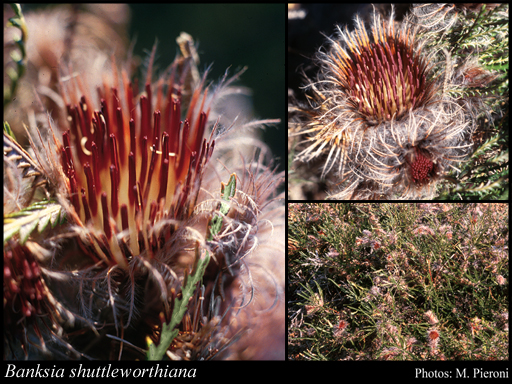- Reference
- Austral.Syst.Bot. 20:70 (2007)
- Conservation Code
- Not threatened
- Naturalised Status
- Native to Western Australia
- Name Status
- Current
Low, spreading, lignotuberous shrub, 0.3-1 m high. Fl. cream-brown-purple, Jun to Sep or Dec or Jan. Grey or yellow sand, often over laterite, lateritic gravel.

Scientific Description
Shrubs, 0.5-3 m high; branchlets hairy. Leaves petiolate, alternate, 55-110 mm long, 4-7 mm wide, hairy; petiole 5-8 mm long; lamina flat, once divided, pinnately divided, divided to the midrib, with 15-42 lobes on each side, the margins revolute. Inflorescences hirsute (with long, rough and coarse hairs), cream or purple; innermost bracts 28-30 mm long, hairy. Perianth 26-32 mm long, hairy, with a few scattered hairs, without awns; pistil 28-32 mm long, straight, style hairy. Follicles hairy, tomentose (with matted or tangled, soft, woolly hairs), obovate, 16-24 mm long. Flowers in July, August or September. Occurs in the South-west (SW) Botanical Province(s), in the Geraldton Sandplains (GS), Swan Coastal Plain (SWA), Avon Wheatbelt (AW) or Jarrah Forest (JF) IBRA subregion(s).
Distribution
- IBRA Regions
- Avon Wheatbelt, Geraldton Sandplains, Jarrah Forest, Swan Coastal Plain.
- IBRA Subregions
- Dandaragan Plateau, Geraldton Hills, Lesueur Sandplain, Merredin, Northern Jarrah Forest, Perth.
- Local Government Areas (LGAs)
- Carnamah, Coorow, Dandaragan, Gingin, Greater Geraldton, Irwin, Mingenew, Moora, Three Springs, Victoria Plains.